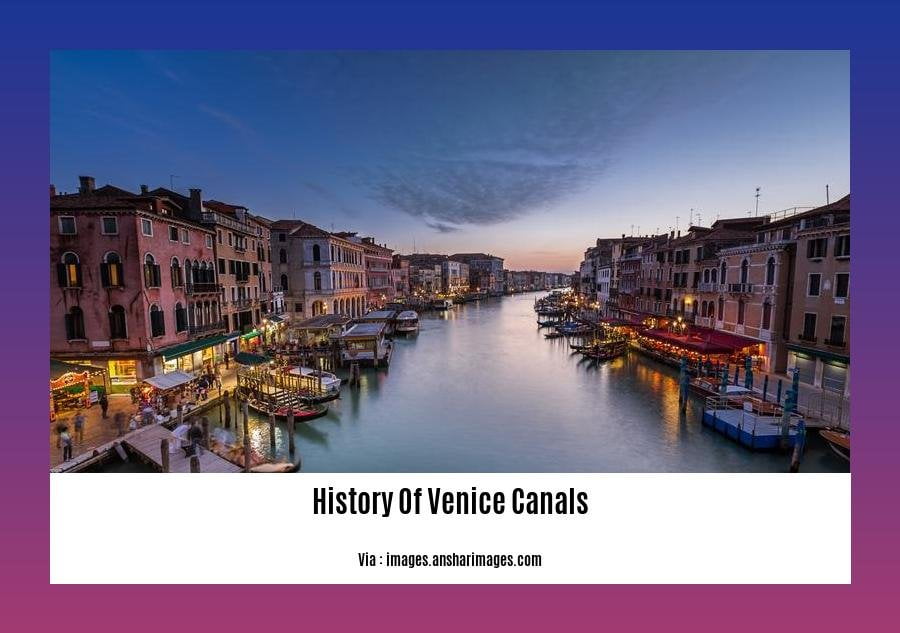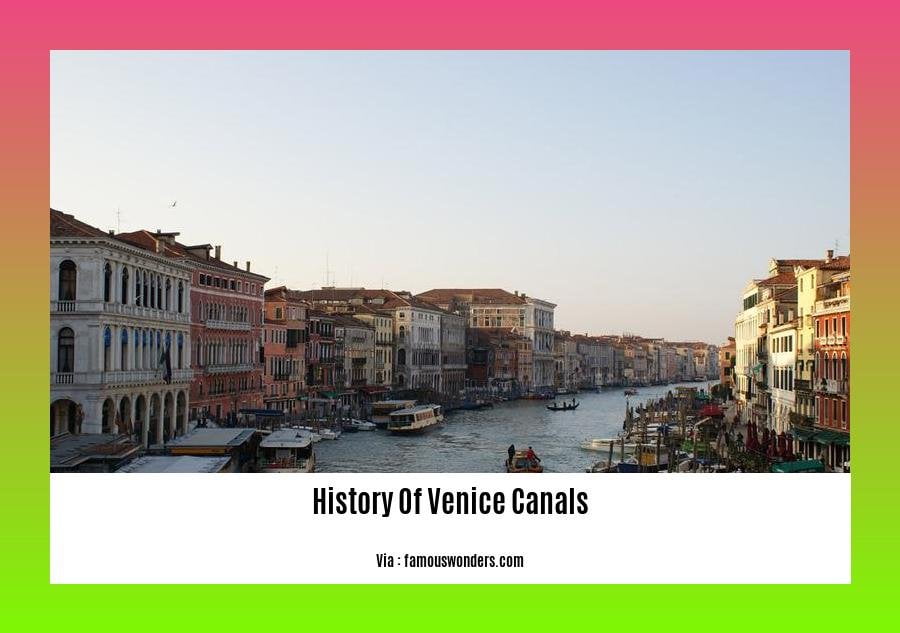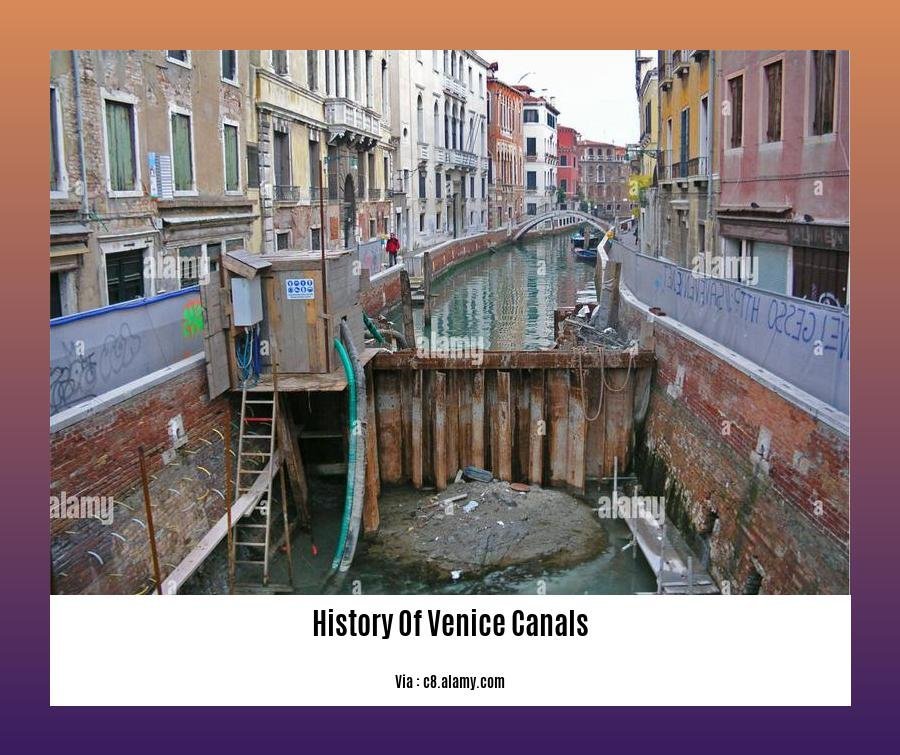Embark on “A Journey Through Time: Unveiling the Rich History of Venice Canals.” In this captivating narrative, we delve into the timeless allure of Venice’s iconic waterways, tracing their evolution from ancient trading routes to the vibrant lifelines of today.
Key Takeaways:
Venice’s canals were built by early settlers to expand and defend the islands.
The canals were dug to drain the lagoon, build banks, and create transportation routes.
The Grand Canal is the main waterway, lined with historic buildings.
Canal depths vary, from 5 meters in the Grand Canal to 17 meters in the Canale della Giudecca.
Wooden stakes form the foundation of the canals, ensuring stability.
Regular dredging and maintenance keep the canals navigable and prevent flooding.
History of Venice Canals

Venice, a city of canals, holds a rich tapestry of history woven around its waterways. Let’s explore the fascinating journey of these iconic canals.
The Genesis of Venice’s Canals
- Venice was built on a network of 118 small islands in a shallow lagoon.
- Early settlers, seeking a strategic location with natural defenses, found the marshy lagoon ideal.
- To protect themselves from flooding and create connections between the islands, they began digging canals and constructing embankments.
- This resourceful engineering endeavor laid the foundation for the city’s unique character.
Navigating Through Canals
- Venice’s canals were, and still are, the city’s main thoroughfares, serving as paths for transportation and trade.
- The Grand Canal, the city’s largest waterway, winds its way through the heart of Venice, connecting major landmarks and offering stunning views.
- Over 400 bridges crisscross the canals, allowing pedestrians to traverse the city’s many islands.
- The iconic gondolas, with their graceful movements, have become an enduring symbol of Venetian charm.
Layers of History Etched in Stone
- The canals offer a glimpse into Venice’s rich past and the architectural marvels that line their banks.
- Palazzos, churches, and monuments from various eras stand testament to the city’s artistic and cultural heritage.
- The interplay of water and architecture creates a picturesque canvas that has inspired artists and writers throughout history.
Embracing Daily Life
- Beyond their historical significance, Venice’s canals are an integral part of daily life for its residents.
- Locals use the canals to commute to work, run errands, and socialize.
- Markets, shops, and restaurants line the canals, creating a vibrant atmosphere.
- The canals provide a unique perspective on the city, offering a serene retreat from the bustling streets.
A Living Legacy: Challenges and Preservation
- Despite their enduring charm, Venice’s canals face challenges due to rising sea levels, pollution, and the influx of tourism.
- Ongoing efforts are underway to preserve and protect this fragile ecosystem.
- The city’s intricate system of canals remains a testament to human ingenuity, adaptability, and the enduring spirit of Venice.
Did You Know?
- The upkeep of the canals is a continuous process, requiring regular dredging to remove sediment and ensure navigability.
- The canals served as a crucial defense mechanism, protecting Venice from naval attacks and providing a means to transport troops and supplies swiftly.
- Water taxis, known as vaporetti, provide public transportation along the canals, allowing visitors and locals to explore the city from a unique vantage point.
- Venice’s canals once teemed with gondolas, which were the primary mode of transportation before the advent of motorized boats. Today, they are mainly used for leisure and tourism.
Want to trace the progression of the sport in America? Dive into the comprehensive history of volleyball in the United States for a chronological account of its development.
History of Volleyball in the United StatesExplore the captivating history of volleyball in the Philippines, tracing its humble beginnings to its rise as a beloved national sport. Delve into the stories of legendary players, memorable matches, and the evolution of the game in the country. History of Volleyball in the Philippines
Unravel the fascinating history of volleyball in Sri Lanka, from its introduction to the island nation to its growth into a popular and widely played sport. Discover the key figures, significant events, and challenges that have shaped the game’s journey in Sri Lanka. History of Volleyball in Sri Lanka
Embark on a journey through the rich history of the United States of America, exploring its captivating narrative from the colonial era to the present day. Discover the stories that shaped a nation, from the founding fathers to the civil rights movement and beyond. History of USA
Delve into the treasure trove of past papers for the History of USA course, providing invaluable insights into exam patterns, frequently tested topics, and essential concepts. Equip yourself with the knowledge and strategies needed to excel in your exams. History of USA Past Papers
Venice Canals: The Lifeblood of a Maritime Empire

Centuries ago, a humble collection of marshy islands in the Adriatic Sea transformed into one of the world’s most powerful maritime empires, thanks in large part to its intricate network of canals. Venice canals played a crucial role in the city’s rise as a maritime power, enabling trade, transportation, and the forging of a maritime empire that spanned centuries.
Unveiling the Essence of Venetian Canals
Imagine a city where graceful gondolas glide through narrow waterways, connecting a labyrinth of islands and creating a captivating cityscape. This is Venice, a city where canals are not just thoroughfares but the very lifeblood of its existence.
The Maritime Lifeline
The canals served as Venice’s lifeline, connecting it to the world beyond its lagoon. Merchant ships laden with goods from far-off lands sailed through these waterways, transforming Venice into a bustling hub of commerce. The city’s strategic location at the crossroads of trade routes made it a gateway for goods from the East to reach the markets of Europe.
A Catalyst for Cultural Exchange
The constant flow of trade brought with it a rich exchange of cultures, ideas, and artistic influences. Venice became a melting pot of diverse traditions, reflected in its architecture, cuisine, and language. This cultural fusion shaped the city’s unique identity and contributed to its enduring allure.
Key Takeaways:
- Venice’s canals were essential for trade and the transportation of goods, contributing to the city’s rise as a maritime power.
- The intricate network of waterways facilitated efficient movement of people and goods, connecting different parts of the city.
- The canals played a pivotal role in the development of Venice’s unique architecture and culture, creating a harmonious blend of buildings, bridges, and waterways.
References:
The canals provided a network for transporting goods and people, which facilitated the growth of Venice’s economy
The canals of Venice, a testament to human ingenuity and engineering prowess, played a pivotal role in the city’s economic development. Imagine a bustling, vibrant city back in the day, where produce from far-off lands was unloaded onto the docks, their tantalizing aromas filling the air. Merchants bartered and negotiated, the canals serving as their watery marketplace.
The gondolas, with their distinctive shape and skilled oarsmen, were the city’s ‘delivery trucks’, deftly navigating the intricate network of waterways, delivering goods and people to their destinations. The canals also served as arteries for trade, transporting Venetian glass, textiles, and spices across the globe, making the city a hub of commerce, a beacon of economic prosperity.
Think about it: without these canals, Venice’s economy would have been severely constrained. Their existence facilitated efficient and convenient transportation, allowing goods to reach their markets faster, fueling economic growth.
Key Takeaways:
The canals provided an efficient means of transporting people and products throughout the city.
Waterways allowed for the easy movement of goods, fostering trade and commerce.
The canals contributed significantly to Venice’s emergence as a major economic power.
The gondolas acted as the city’s delivery service, facilitating the movement of goods and people.
The canals were crucial for the transportation of Venetian goods, such as glass, textiles, and spices, to markets across the globe.
Relevant URL Sources:
- Canals 1750 to 1900 – History Learning Site
- History of the British canal system – Wikipedia
Venice canals are a unique feature of the city, and they have helped to shape its history and culture.
Imagine wandering through the enchanting city of Venice, where the gentle lapping of water against stone bridges creates a symphony of tranquility.
The canals of Venice are intricate arteries pulsating with life. They’ve played a pivotal role in shaping the city’s history and culture, a testament to human ingenuity and adaptation to a unique environment. Let’s delve into the rich tapestry woven by these iconic waterways:
Venice’s Canals: A Lifeline Rooted in History
The canals were not mere aesthetic additions; they were essential lifelines, a network of transportation routes connecting the lagoon’s many islands. In an era where land-based travel was arduous, the canals offered a convenient and efficient mode of transport. Goods were ferried, people commuted, and commerce flourished along these watery paths.
A City Built on Water: A Testament to Human Ingenuity
Venice’s very existence is a testament to the indomitable spirit of its founders. They defied the challenges of a marshy, unstable terrain and built a city on wooden pilings driven deep into the lagoon bed. These pilings provided a solid foundation for the city’s buildings, bridges, and the canals themselves – an engineering marvel that has stood the test of time.
The Grand Canal: A Showcase of Splendor and Majesty
Imagine gliding along the Grand Canal, the most famous and longest waterway in Venice. Palaces, churches, and bridges line its banks, creating a breathtaking panorama of architectural wonders. It’s a living testament to the city’s artistic heritage, where every building tells a story of opulence, power, and creativity.
A City Embraced by Water: A Unique Cultural Heritage
The canals are not just physical features; they’re deeply embedded in Venetian culture. They’re gathering places, where locals socialize, gossip, and share stories. The rhythm of life revolves around the canals, from the enchanting gondolas serenading tourists to the bustling water taxis zipping by.
A Delicate Balance: Preserving Venice’s Fragile Ecosystem
Venice’s canals face ongoing challenges, from rising sea levels to the impact of tourism. Preserving this delicate ecosystem requires a concerted effort to balance conservation and development. Initiatives to reduce pollution, protect the lagoon’s biodiversity, and promote sustainable tourism are vital to ensuring the canals’ longevity.
Key Takeaways:
- Venice’s canal system is a unique urban feature serving as the city’s primary transportation network.
- Built on wooden pilings, the canals showcase ingenious engineering and adaptation to a challenging environment.
- The Grand Canal, the city’s most famous waterway, offers a glimpse into Venice’s architectural and artistic heritage.
- The canals are deeply ingrained in Venetian culture, serving as gathering places, social hubs, and lifelines for daily life.
- Preserving Venice’s canals requires ongoing efforts to balance conservation and development, ensuring the delicate ecosystem’s sustainability.
For further exploration of Venice’s canals and their historical significance, consider these informative sources:
Venice Canals, Italy: Interesting Facts You Didn’t Know
How Venice’s canals were built on the water? – Venezia Lines
FAQ
Q1: How were the canals of Venice built?
A1: The canals were initially formed by sinking wooden stakes into the lagoon’s muddy bed and later reinforced and stabilized with stone embankments.
Q2: What was the purpose of building canals in Venice?
A2: The canals were constructed to facilitate transportation, enable trade and commerce, and provide a means of defense and protection for the city.
Q3: What is the significance of the Grand Canal?
A3: The Grand Canal is the most prominent waterway in Venice, serving as the city’s main thoroughfare and lined with magnificent palaces, churches, and historical buildings.
Q4: How have the canals influenced Venice’s development and culture?
A4: The canals have played a crucial role in shaping Venice’s unique urban landscape, fostering a distinctive culture and way of life centered around the waterways.
Q5: What are some of the challenges faced in maintaining Venice’s canals?
A5: Preserving and maintaining the canals of Venice is an ongoing challenge due to factors such as sea-level rise, erosion, and the constant need for dredging and upkeep.












